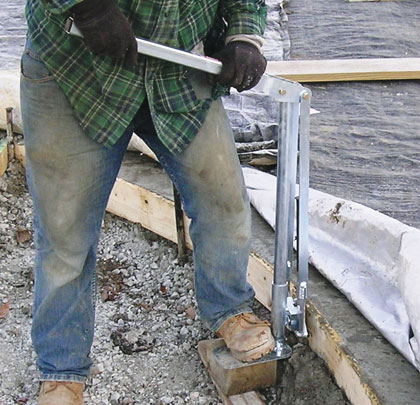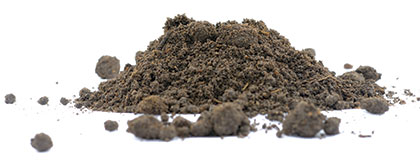JackJaw® pullers allow quick removal of forms and stakes.
Introduced to North America at the World of Concrete in 2008, the patented JackJaw® Extractor (puller) is now commonplace on any jobsite where something needs to be pulled out of the ground. More than 13,000 units are now working every day in the hands of very happy customers all over the world.
DESIGNED TO WORK
All JackJaw pullers are made from heavy gauge steel plate and tubing, and feature opposing hardened jaws attached to a lever arm. When the lever arm is up the jaws are open, when the lever arm is pushed down the jaws close and grip tightly on whatever needs to be pulled out of the ground. Additional pushes on the lever arm extracts the object out of the ground, quickly, effortlessly, and safely for the operator. With more than 40 models now in production, with varying grip widths, jaw sets, and lever arm lengths, there is a JackJaw puller for nearly any job.
Because of the design, JackJaw extractors are safer for workers than other types of pullers. JackJaw pullers extract the post out of the ground in the same direction that it was pounded. The jaw mechanism provides a positive grip that prevents back and shoulder strain that results from the whiplash of other pullers.
INDUSTRY-SPECIFIC USES
The most popular units for construction use are the JJ0200 form stake puller for metal stakes, and the JJ0250 for wood stakes. These pullers permit the contractors to pound their stakes below the top of the form allowing for faster finishing of the concrete and safe, easy, and quick removal of the form’s stakes. Payback is measured in days.
In the public works market, JackJaw extractors are used for pulling many types of street sign posts, U-channel, Square (Telespar/Unistrut), or round posts. An array of JackJaw models are available for pulling any type of sign posts from any condition ranging from soft ground to concrete-like caliche clay. These pullers feature a larger lever arm than their construction counterparts, as the 300 series pullers have a leverage of 16 to 1, and the 500 series pullers have a massive 28 to 1 leverage (mechanical advantage) on the job. This means when you push down on the handle with 100 lbs of force (easy for any worker to do) the JackJaw 300 series pullers create an upward force of 1,600 lbs on the street sign post, easily pulling it out of the ground. Contractors and public works workers in the western states prefer the 500 series pullers where that same 100 lbs of force on the lever arm creates a 2,800 lbs upward force on the sign post. With an accessory table, the 500 series pullers can even pull sign posts with concrete cylinders attached to the bottom. JackJaw extractors in the public works arena make easy and fast work of pulling street signs and city and municipal signs. State DOTs and highway signage contractors can do the job without having to use truck-mounted cranes or heavy hydraulic systems. The JackJaw makes it a one-person job.
Farms and jobsites are full of t-posts for temporary farm wire fencing or orange barricade fencing on jobsites. JackJaw models JJ0203 and JJ0205 pull the t-post quickly and easily without bending the t-post or the spade, allowing reuse of the posts. These models are also popular with real estate agents for pulling real estate signs with little effort.
EROSION CONTROL
Since 2012, hundreds of erosion control contractors have been using JackJaw models JJ0206 and JJ0226 extractors for installing and setting percussion driven earth anchors for holding down erosion control matting. The makers of JackJaw stake pullers and Gripple earth anchors teamed up to develop these models for the benefit of hundreds of their mutual customers. These models do two actions; first they pull the drive rod out of the ground, then, they set the anchor by gently pulling up on the anchor cable. Quickly, easily, and safely. If you need to know how much force the anchor is holding, the model JJ0227 does all the above, plus gives you a digital read out of anchor holding force.
TEMPORARY GROUND RODS
Most generators, pumps, and temporary jobsite trailers have to be grounded while on site. When the job is over, the ground rods must be removed to eliminate the tire and trip hazard associated with them. The job is easy for JackJaw models JJ0300, J0400 and JJ0500. With any of these models, pulling a ground rod from 8 feet deep takes only about 30-40 seconds, with very little effort. If you have deep grounding rods, say 15-20 feet deep, use the JJ0500 with its 28 to 1 leverage. Hundreds of these models are in use by temporary power companies (generator rentals), oil field services companies, public utilities and the U.S. military for safely, easily, and quickly pulling ground rods. Hundreds more are used by gas companies for pulling gas probes used to find gas leaks in natural gas lines.
The tent rental industry was changed forever in 2008 by the introduction of a line of JackJaw tent stake pullers for pulling long and large diameter tent stakes that are used to anchor commercial tents for events. The JackJaw models JJ0302 and JJ0502 have dramatically shortened the time required to pull stakes from large tent events. Thousands of units are in use every day by tent rental companies. The JackJaw makes the worst job in the industry (pulling the tent stakes) into the easiest job.
OTHER APPLICATIONS
Other applications for the JackJaw extractors include pulling injection rods for concrete and soil stabilization, pulling pallet posts from industrial storage, pulling dock posts from lake docks, and pulling TV cables through casings. Just about anything that needs to be pulled from the ground can be pulled with one of the JackJaw models.
For More Information:
JackJaw Extractors are produced in Dayton, Ohio. For more information, call or email Bob Anderson, president of Construction Accessories, Inc. the manufacturer of the JackJaw® line of pullers and extractors. Bob can be reached at bob@jackjaw.com or 937.609.8937. For more information and operating instruction videos, visit www.jackjaw.com.
_________________________________________________________________________
Modern Contractor Solutions, February 2018
Did you enjoy this article?
Subscribe to the FREE Digital Edition of Modern Contractor Solutions magazine.




